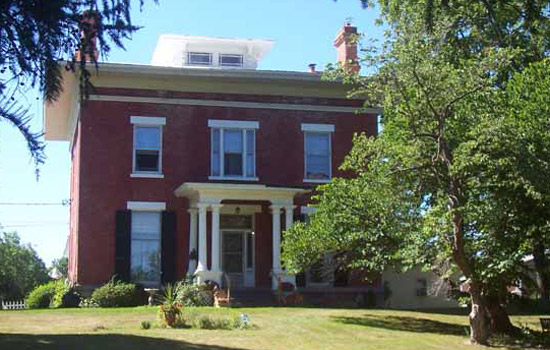Class project brings life to history
Students makes use of original house diagrams, New York state architectural history and alumni connections
The historic Asa Rowe House in Greece, N.Y., became a test lab for Hospitality and Service Management students this spring.
What began as a quiet drive in the country became inspiration for a class project that touched on several New York state historical connections.
David Crumb, associate professor in the School of Hospitality and Service Management, was on a drive with his wife, Mari, when they chanced upon an open house at 1669 Reed Road, the former home of Asa Rowe, founder of Greece, N.Y., and a prominent landowner and early nurseryman.
While walking through the 19th century home currently up for sale, Crumb had an idea for the new elective class he was going to teach, Real Estate for the Hospitality Industry. He thought the class would be more meaningful if the students went through the exercise of restoring a historic home and developing a business as if they had, in fact, purchased the home.
Through the course of 11 weeks this past spring, Crumb and the students developed a plan for turning the home into a classic bed-and-breakfast operation with banquet and conference facilities.
The 6,000-square-foot Rowe home was designed by Rochester architect Merwin Austin in 1854. Asa Rowe and his family established a number of businesses, most notably Rowe Photo. The home was auctioned in 1960, when members of the Brown family purchased it for $14,000. Several generations lived in the home until its current owners, Doug and Jeanne Brown, decided to put it up for sale.
Crumb divided the students into groups assigned to relevant areas including physical improvements, operations, marketing and finance.
“I think the most challenging part was the vision of the home,” says Sarah Dagg, a third-year hospitality student from Paris, Ontario, Canada. “Most of us walked in there and thought that this would be a lot of work.”
The students began to look at businesses similar to what they intended to develop. One visit took the students to The Senator’s Mansion, a Greek-Revival home in Churchville, N.Y. The mansion is home to Chris Steubing ’79, ’82 (food service administration) and his wife, Lisa, and the banquet facility on the property is a popular location for weddings and corporate events.
“I could relate to the project that the students were working on as I actually went through the ups and downs of becoming self-employed some 14 years ago,” Steubing says. “I was working for another caterer at the time and learned a lot of what to do and particularly, what not to do, when you go into business for yourself. I was happy to share my experiences.”
His project began when he saw the mansion listed for sale in the local paper.
“I decided to purchase it,” he says. “I met with the village board to see if it was do-able. They loved the idea. Then came the bank, the attorney, the architect, the accountant, the contractor, the headaches, the decorator, designing a menu, applying for a tax number and a DBA, picking out china, tables, chairs, carpets, glassware, hiring staff, getting insurance and permits and liquor licenses, etc. I get tired just thinking about this again,” he adds with a laugh.
Steubing was only one of several local business leaders who mentored the class, including architect Roger Brown, attorney John Foster and realtor Bob Nelson. Cynthia Howk, architectural research coordinator from the Landmark Society of Western New York, discussed the Asa Rowe House history, requirements for maintaining a historic home and some of the tax credit opportunities.
“One major positive with this project is all of the help we received from many people outside of RIT, like Jeannie Brown, the current homeowner, who opened her house to us and let us use it for our project,” says Erin O'Rourke, a third-year business management major from Webster, N.Y.
Building codes, variances and fire safety compliance were also part of the research. The project plan called for an eight-room bed-and-breakfast facility, but town codes set a limit of five guest rooms. This meant a visit to town hall to learn about the process of filing petitions and requesting an exception.
Keri Nelson, a fourth-year hospitality student from Alexandria Bay, N. Y., led the finance team that estimated the restoration and repairs at approximately $200,000, not including the furnishings or the new building proposed for a banquet facility.
“I believe that the hardest part of a project is the numbers part. It is easy to dream big, but hard to figure out the finances,” she says.
Looking at the bottom line, the costs to renovate the mansion were substantial, but the financial plan also saw a significant return on investment within five years, says Nelson.
For the students, the project provided learning that went beyond theory.
“I really liked how this class was set up as a really big project,” says Dan Solliday, a first-year hospitality student from Unionville, Conn. “It was good to use a real-life application and talk to the real people needed, as if we were actually going to buy the house and turn it into a bed and breakfast.”
Says O’ Rourke, “Dreaming up ideas is easy, but actually putting them into motion takes determination, dedication—and a lot of money.”







